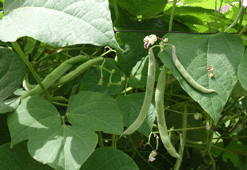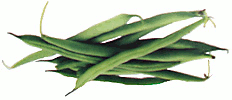• Mung bean sprouts contain rich quantities of Vitamin A, B, C and E. They are also known to be an excellent source of many minerals, such as calcium, iron and potassium.
• The bean is popular as the perfect food for reducing weight. It is recommended as a food replacement in many slimming programs, as it has a very low fat content. It is a rich source of protein and fiber, which helps one to lower the high cholesterol level in the blood system.
• The high fiber content of mung beans yields complex carbohydrates, which aid digestion. Complex carbs are also effective in stabilizing blood sugar and prevent its rapid rise after meal consumption, apart from keeping body’s energy at a balanced level. Those who suffer from diabetes or high cholesterol are recommended frequent consumption of mung bean.
• In Chinese medicine, mung bean sprouts are considered as a cooling food, containing anti-cancer properties. Herbalists use them for all hot, inflammatory conditions, ranging from systematic infections to heat stroke and even hypertension.
More informations on Green beans
Green beans nutrition facts
 Tender, flexible green beans are a delight of vegetarian lovers for their wholesome nutritional qualities. They are unripe or immature pods obtained from the bean plant belonging to common Fabaceae family, and known scientifically as Phaseolus vulgaris.
Tender, flexible green beans are a delight of vegetarian lovers for their wholesome nutritional qualities. They are unripe or immature pods obtained from the bean plant belonging to common Fabaceae family, and known scientifically as Phaseolus vulgaris.
Broadly, tender beans are classified depending on their growth habits as "bush beans" which stand erect without support and "Pole Beans" that need climb supports. The other varieties of unripe fruits of bean family include shell beans, Pinto or mottled beans, White beans, Red or kidney beans, Black beans, Pink beans and Yellow wax beans. All most all the varieties are available year around across the world.Fava or broad beans (Vicia faba) are large, flattened light green pods usually eaten shelled for their delicious beans. Lima beans (Phaseolus lunatus) are large, plump, pale-green pods with kidney-shaped seeds.
Health benefits of Green beans
- Fresh green beans are very low in calories (31 kcal per 100 g of raw beans) and contain no saturated fat. Nevertheless, the lean vegetables are a very good source of vitamins, minerals, and plant derived micronutrients.
- They are very rich source of dietary fiber (9% per100g RDA) which acts as a bulk laxative that helps to protect the mucous membrane of the colon by decreasing its exposure time to toxic substances as well as by binding to cancer-causing chemicals in the colon. Adequate amount of fiber has also been shown to reduce blood cholesterol levels by decreasing reabsorption of cholesterol-binding bile acids in the colon.
- Green beans contain excellent levels of vitamin A, and health promoting flavonoid poly phenolic antioxidants such as lutein, zea-xanthin and ß-carotene in good amounts. These compounds help act as protective scavengers against oxygen-derived free radicals and reactive oxygen species (ROS) that play a role in aging and various disease processes.
- Zea-xanthin, an important dietary carotenoid in the beans, selectively absorbed into the retinal macula lutea in the eyes where it thought to provide antioxidant and protective UV light filtering functions. It is, therefore, green beans offer some protection in preventing age-related macular disease (ARMD) in the elderly.
- Snap beans are a good source of folates. 100 g fresh beans provide 37 µg or 9% of folates. Folate along with vitamin B-12 is one of the essential components of DNA synthesis and cell division. Good folate diet when given during preconception periods and during pregnancy helps prevent neural-tube defects among the offspring.
- They also contain good amounts of vitamin-B6 (pyridoxine), thiamin (vitamin B-1), and vitamin-C. Consumption of foods rich in vitamin C helps the body develop resistance against infectious agents and scavenge harmful oxygen-free radicals.
- In addition, beans contain healthy amounts of minerals like iron, calcium, magnesium, manganese, and potassium, which are very essential for body metabolism. Manganese is a co-factor for the antioxidant enzyme, superoxide dismutase, which is a very powerful free radical scavenger. Potassium is an important component of cell and body fluids that helps controlling heart rate and blood pressure.
Selection and storage

Raw fresh green beans, also called as snap beans or French beans, should be tender, long, stiff, but flexible and give snap sound when broken. Buy them from organic stores for their rich “beany” flavor.
Avoid limp or overly matured beans with tough skin.
To store, place them in a perforated plastic bag and keep inside the refrigerator set at high relative humidity. They keep well for up to a week.
Preparation and serving methods
Wash raw beans in cold water. Just before using, remove the strings and trim the ends.
Here are some serving tips:
- Green beans are among the most-favored vegetable items in stir-fry, stews, grilled-salads, Steamed along with carrots, cauliflower, peas, tomato...etc.
- They mix well with cheese, nuts, mushroom, seafood, meat, etc.
- In Asian region, they are used in curries, soups, stir-fry with rice (rice pilaf) etc.
Safety profile
Green beans contain oxalic acid, a naturally-occurring substance found in some vegetables, which, may crystallize as oxalate-stones in the urinary tract in some people. People with known history of oxalate urinary tract stones are advised against eating vegetables belong to Brassica and Fagaceae family. Adequate intake of water is, therefore, advised to maintain normal urine output to minimize the stone risk. (Medical disclaimer).
Source: Healthy world US, Natural remedy US
www.gooddeedsmall.com
Source: Healthy world US, Natural remedy US
www.gooddeedsmall.com

No comments:
Post a Comment